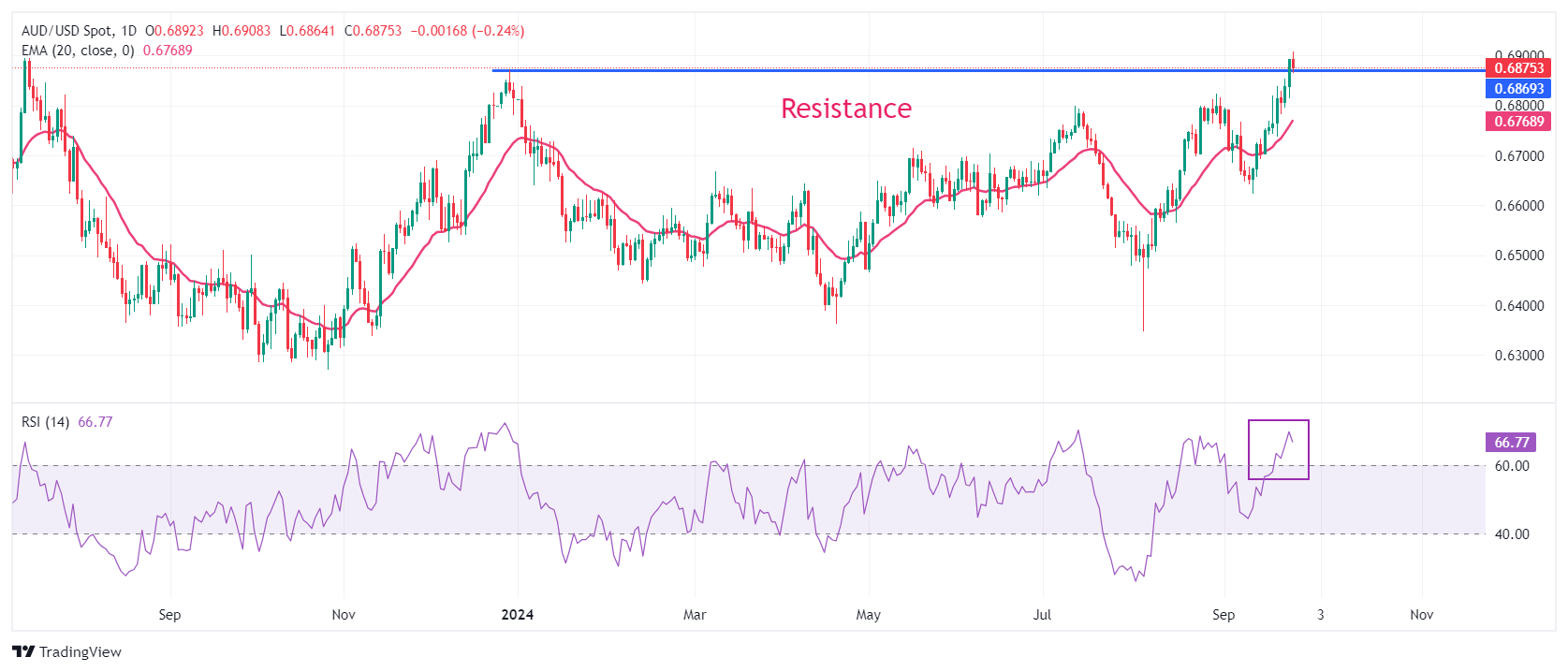- AUD/USD struggles to extend its upside above 0.6900, while its upside remains firm.
- The Australian Dollar remains firm as the RBA is expected to keep interest rates steady at their current levels for the entire year.
- Firm Fed large rate cut bets weigh on the US Dollar.
The AUD/USD pair edges lower after posting a fresh yearly high around 0.6900 in Wednesday’s North American session. The broader outlook of the Aussie asset remains firm as the Reserve Bank of Australia (RBA) signaled in its monetary policy meeting on Tuesday that interest rates will remain at their current levels by the year-end.
The Australian Dollar (AUD) is also strengthened by the announcement of China’s massive stimulus to boost household spending and revive the real estate sector. Being a proxy for China’s economic growth, the AUD receives higher flows if China’s outlook improves.
Meanwhile, the US Dollar (USD) has fallen back after a short-lived recovery. The US Dollar Index (DXY), which tracks the Greenback’s value against six major currencies, retreats to 100.20, the lowest level seen in more than a year.
The US Dollar would continue to face pressure as market participants expect that the Federal Reserve (Fed) will cut interest rates consecutively for the second time by 50 basis points (bps) in the November monetary policy.
AUD/USD reclaims the horizontal resistance plotted from 28 December 2023 high of 0.6870 on a daily timeframe. The near-term trend is bullish as the 20-day Exponential Moving Average (EMA) at 0.6770 is sloping higher.
The 14-day Relative Strength Index (RSI) shifts above 60.00, suggesting an active bullish momentum.
The Aussie asset will witness a fresh upside move if it breaks above the intraday high of 0.6910, which will drive the asset to near the 16 February 2023 high of 0.6936, followed by the psychological resistance of 0.7000.
On the flip side, a downside move below September 19 of 0.6738 will drag the asset toward round-level support of 0.6700 and a September 12 low of 0.6656.
AUD/USD daily chart
Australian Dollar FAQs
One of the most significant factors for the Australian Dollar (AUD) is the level of interest rates set by the Reserve Bank of Australia (RBA). Because Australia is a resource-rich country another key driver is the price of its biggest export, Iron Ore. The health of the Chinese economy, its largest trading partner, is a factor, as well as inflation in Australia, its growth rate and Trade Balance. Market sentiment – whether investors are taking on more risky assets (risk-on) or seeking safe-havens (risk-off) – is also a factor, with risk-on positive for AUD.
The Reserve Bank of Australia (RBA) influences the Australian Dollar (AUD) by setting the level of interest rates that Australian banks can lend to each other. This influences the level of interest rates in the economy as a whole. The main goal of the RBA is to maintain a stable inflation rate of 2-3% by adjusting interest rates up or down. Relatively high interest rates compared to other major central banks support the AUD, and the opposite for relatively low. The RBA can also use quantitative easing and tightening to influence credit conditions, with the former AUD-negative and the latter AUD-positive.
China is Australia’s largest trading partner so the health of the Chinese economy is a major influence on the value of the Australian Dollar (AUD). When the Chinese economy is doing well it purchases more raw materials, goods and services from Australia, lifting demand for the AUD, and pushing up its value. The opposite is the case when the Chinese economy is not growing as fast as expected. Positive or negative surprises in Chinese growth data, therefore, often have a direct impact on the Australian Dollar and its pairs.
Iron Ore is Australia’s largest export, accounting for $118 billion a year according to data from 2021, with China as its primary destination. The price of Iron Ore, therefore, can be a driver of the Australian Dollar. Generally, if the price of Iron Ore rises, AUD also goes up, as aggregate demand for the currency increases. The opposite is the case if the price of Iron Ore falls. Higher Iron Ore prices also tend to result in a greater likelihood of a positive Trade Balance for Australia, which is also positive of the AUD.
The Trade Balance, which is the difference between what a country earns from its exports versus what it pays for its imports, is another factor that can influence the value of the Australian Dollar. If Australia produces highly sought after exports, then its currency will gain in value purely from the surplus demand created from foreign buyers seeking to purchase its exports versus what it spends to purchase imports. Therefore, a positive net Trade Balance strengthens the AUD, with the opposite effect if the Trade Balance is negative.

